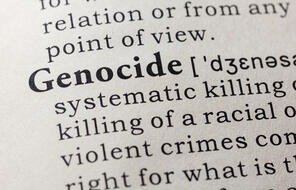Breadcrumb
- Home
- Get Involved
- Experience Facing History
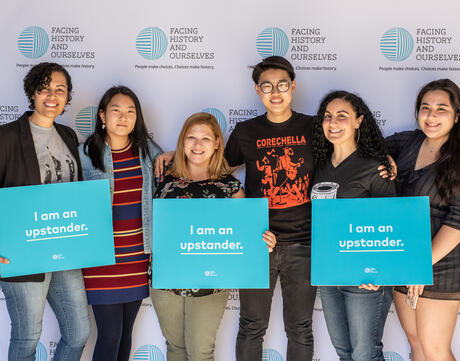
Experience Facing History
The power of Facing History is undeniable. Experience it first hand.
From one classroom in Brookline, Massachusetts in 1976, Facing History & Ourselves has become a global organization that supports thousands of schools, hundreds of thousands of teachers, and millions of students worldwide.
Observe Experienced Educators
Watch these videos to get a glimpse into a Facing History classroom. Observe experienced educators put our unique approach into action and see students engaged in their learning, making connections betweens the lessons on the page and the world around them.
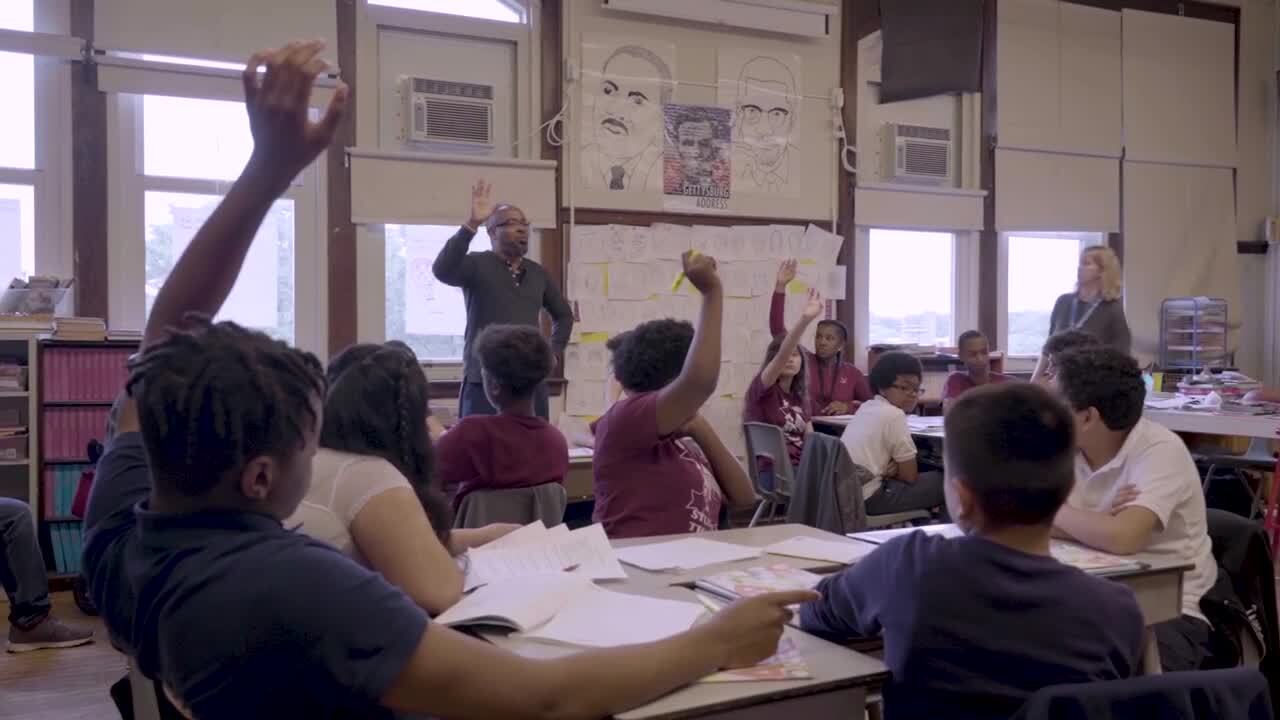
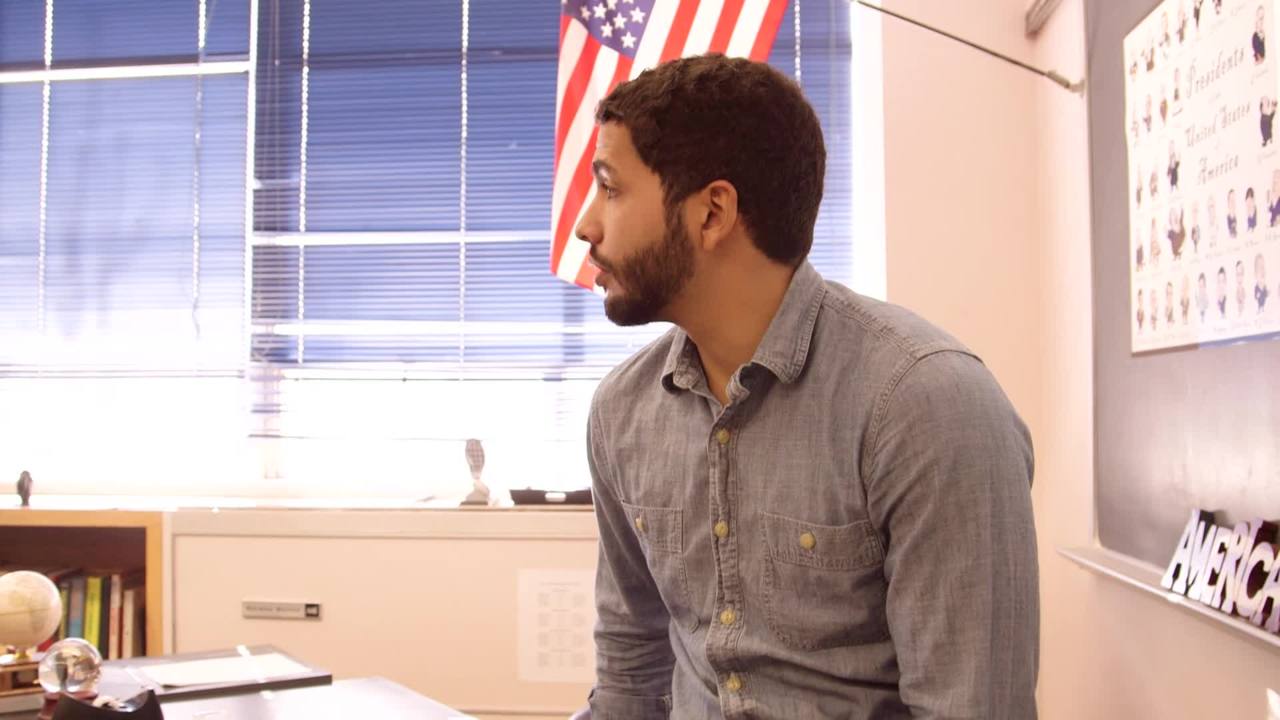
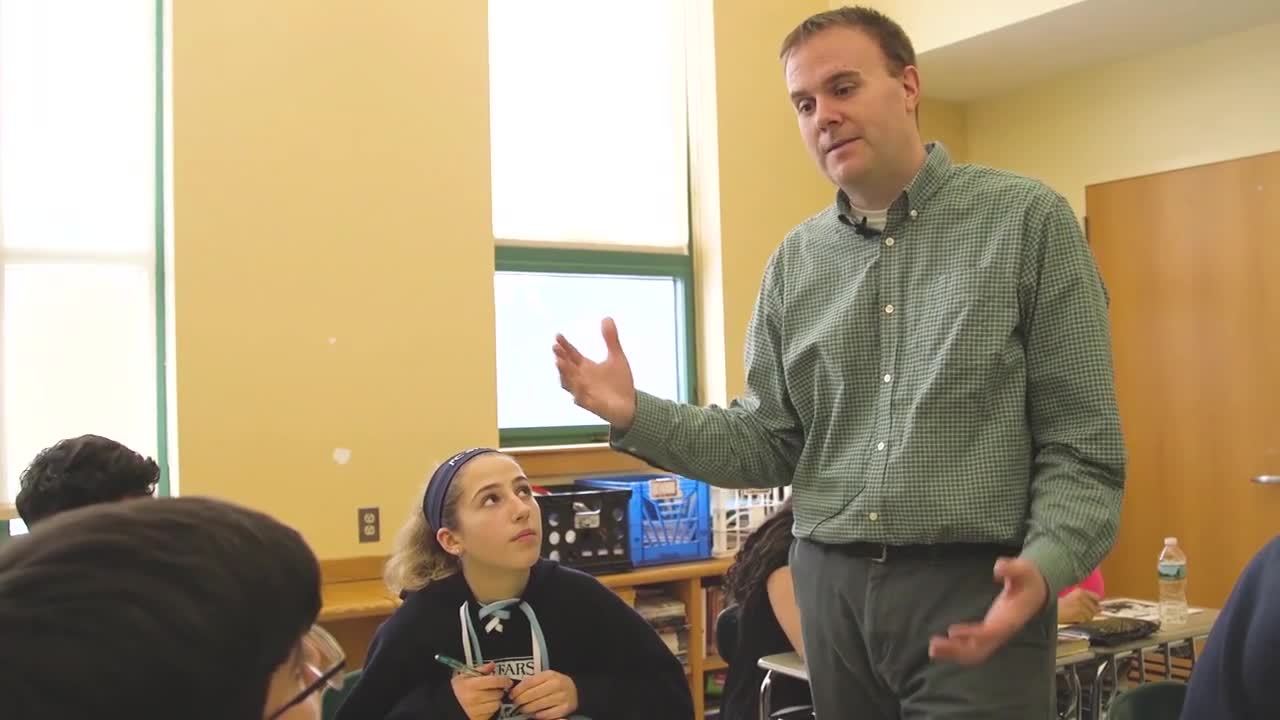
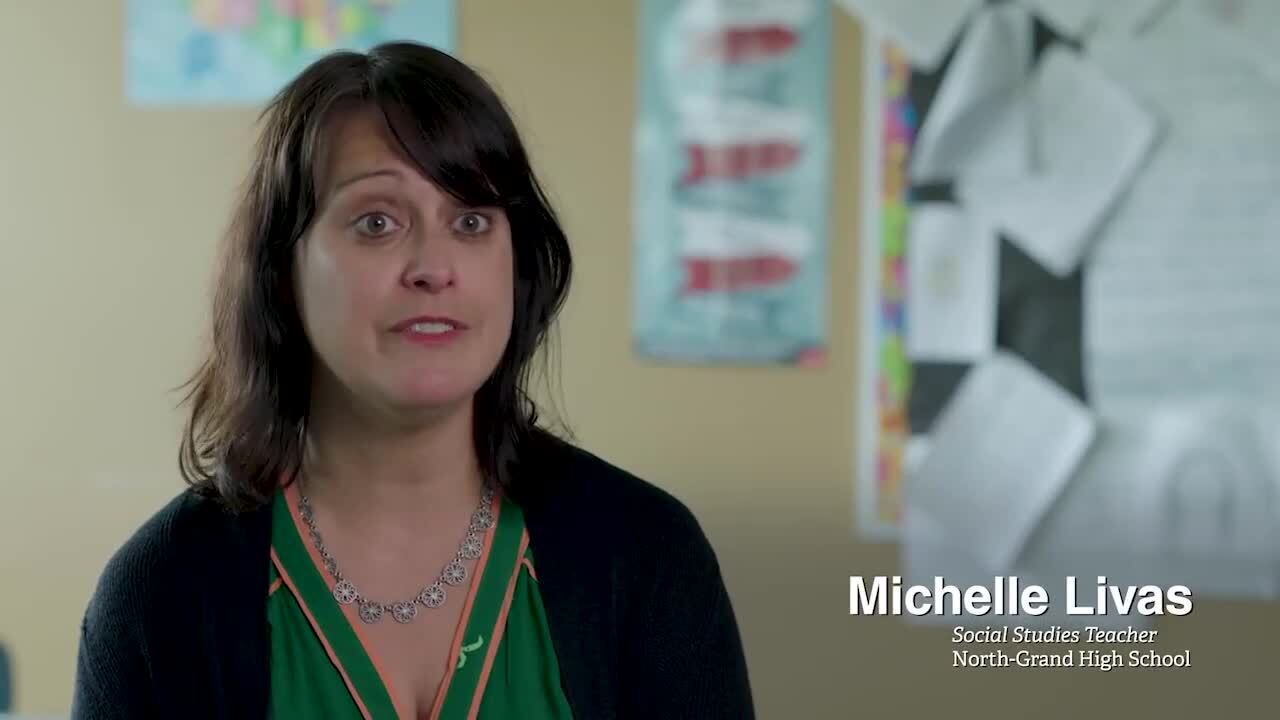
Take one minute and think about a first day, ideally, eighth grade since you're about to leave. Think about your first day. O'Reilly? I was nervous because I didn't know that I would be making new friends. You were nervous in not knowing if you were going to be able to make new friends. Ahmed, yeah? It was when I was coming into eighth grade. I didn't even know where the front door was or which class. You didn't know where the front door was or what class and where the class was going to be. Yeah. I started out as an art teacher. So I wasn't really familiar with the social science curriculum. A teacher told me about Facing History. And I went to a workshop actually in Little Rock. It was during the summer. It opened my eyes. I was like, oh my gosh, this is what I should be teaching. This is the way I should be teaching. It was a game changer, definitely was a game changer. It changed the way that I teach. It opened up so many doors as far as history itself, like looking at multiple perspectives of events that happened throughout history. I initially started this year off thinking about identity, diversity, and what role it plays in every student's life, and how a person's identity, how the world sees them, how that may influence their roles in society itself. So how you look at me or how I look at myself, how does that image help me maneuver through our society in a positive way? The lesson that I will be doing really focuses on the Little Rock Nines first day into Central High and the commotion it caused, the backlash, political ramifications that came from this event yes and how society reacted to these nine black children going to an allwhite high school. If you were a parent, remember I asked you guys this, if you were a parent, would you send your child to a school knowing all of this harassment or what may happen? I'm still trying to figure out why. Edward, then Alonzo, then Ila very quickly. As a parent, I wouldn't let them because I know that they're not going to be welcome there because of their skin color. Let me ask you this then. This is what I asked yesterday. Do you think that's right? No. So you know it's wrong. Yeah. You know it's wrong that if you send your child to a school, they will be judged by their skin color. You know it's wrong. Yeah. But you still wouldn't do it? I said something about that. You said something, yeah. I want to do Alonzo first then you. Yes? I also agree with Edward because I would be concerned for my child's safety since I know that something could happen like that. Even though you know what's happening is wrong. I have a question. I'm leading up to something. Yes? Yeah. So just like I said yesterday, I know what's going to happen. But even though it's wrong, the people who are against segregation and who've supported the idea, they're not the one that's going to feel the pain of something like the success of it. You're the one that's going to be feeling it. So the people who are trying to support integration-- Or are against it. --or going against it, going against segregation, they're not sending their child. You're sending your child. Yeah. So if something happens to your child-- You feel the pain. You feel it. Not the other people. Not the other people. I love this lesson for several different reasons. The thing that excites me the most is touching on things that have happened in the past that I feel like students either have experienced now or will experience later on in their lives. We started off at the beginning of the year talking about the Civil War and how our nation was divided due to so many different issues. The culture and the climate that we're in right now where race and gender, nationality, or citizenship, these issues of identity are so huge. We go back and we look at things like what happened in Little Rock as far as segregation and judging people and not wanting to be next to someone because we're afraid of what might happen. And the fact that my classroom is extremely diverse, showing them that what you may be experiencing now is not something that is 60, 70 years old. This is something that's very recent.
Connecting Past and Present
In this classroom video, social studies teacher Tareeq Rasheed teaches the lesson “The First Day of School” from the Choices in Little Rock unit. This lesson examines the decisions that the citizens of Little Rock, Arkansas made in response to Brown v. Board of Education and the desegregation of the city’s largest and most prestigious high school. Watch the class explore civic choices—the decisions people make as participants in a liberal democracy.
[KEVIN TORO] Reconstruction is so often not taught in our schools. And so we're doing a good job here in Arlington of trying to push it in our US2 classes. But so often, we're also kind of struggling for time just to finish and set the end of US1. So in that sense, I'm trying to fill in as much as possible, this lost history that I feel like we don't have home, as well as misrepresented history. I'm hoping that they realize, through the documents that I'm going to show them, that people were resisting. There was resiliency, and resiliency is a huge part of this whole semester-- rather, course-- because I feel like, often, we teach this sort of as victimhood and sort of instead of focusing on sort of how they survived, and why they survived, as well as how they thrive. What I really want them to get out of this lesson is that these people were using this newly acquired freedom in ways that we can see throughout US history-- is legitimate and is the way that we usually see people. I want to sort of normalize this behavior of resiliency of marginalized communities. So today, as we talked about before when we sort of hinted with Reconstruction, we have this contested history that's not necessarily taught. We have just pieces of missing history as well as misinformation that has been taught over years and years, decades and decades at this point, right? We're going to get to the point where it's going to be hundreds of years of this history that teaches the reconstruction as the black failure to govern. So what I want to start us off with is actually looking at some of the sources of the time. So we're going to pass these out, and then we're going to go over them. I will give you further instruction. As you get them, feel free to read. Because we will be going over them individually and reading over them individually, and then coming together as a class, as we often do, all right? I want to just read that first sentence for you, and then you all can read it on your own, all right? The following is an excerpt from historian Leon Litwack's book, Been in the Storm so Long. And before you start reading, what I'd like for you all to do is think about this question as you are doing so. How does Leon Litwack describe the newly acquired freedom of former slaves? Keep that in mind as you're reading. It is something that we're going to discuss afterwards. Let's say-- what are you all feeling, 10 or 15 minutes? [STUDENT 1] 10. [KEVIN TORO] 10? Well, I think that sounds good. 10 minutes. So we have our question, right? How does he describe this newly acquired freedom? Go ahead, Diego, and then Julian. Start us off. [DIEGO] So basically, he just kind of describes it as not really-- I mean, he does say, at one point, what they can do now because of their freedom, but he just more describes that as them having the confidence to not have to obey white people and more just-- yeah, just being able to not obey them. I think that's what he focused on the most, rather than what they can do now. [KEVIN TORO] Yeah, good, good. Julian, follow-up? [JULIEN] Yeah, I said they had the ability to belong to themselves. So they don't have to listen to others, and they can do what they wanted to do with-- they could own their own things. [KEVIN TORO] Yeah, so we have, right now, the sort of-- I want to summarize what both of you said. So, Julian, we're going to start with yours, all right? You've talked about sort of property, right? So would it be fair of me to summarize that as the right to own or a right to property? OK, good. In that sense, we know that that's an aspect of it. So what would we consider that relationship, in terms of the definition of racism that I gave everyone previously? And if anyone would like to jump in and help Diego, they can. [DIEGO] Yes, please. [KEVIN TORO] [LAUGHS] Mikayla, would you-- [MIKAYLA] Power? [KEVIN TORO] Power. Power in terms of what? If anyone would still like to jump in-- Georgia? [GEORGIA] The power distribution kind of falls less into the hands of white people. [KEVIN TORO] And what do we call that? What's the two-- [GEORGIA] Well, it kind of reverses white supremacy. [KEVIN TORO] Wonderful. So we are talking about this white supremacy. So sort of in a demolition or deconstruction of white supremacy is what we've all come to now as well as the sort of right to own property. I think those are two solid ones that we could possibly write down, if you haven't already. [CHUCKLES] All right. [COLE] I don't know how to say it without sounding cheesy. Like, is freedom really being free? Even while being free, it's like, there's still obligations. And freedom is the ability to do and choose what you want to do as freely as you want. But even while being free, there's still things that bind you to a schedule. [KEVIN TORO] Absolutely. So you have an opportunity, right? So that's going to be a good sort of word that we're going to use. But with that opportunity comes what? I want in one word. Mikayla? [MIKAYLA] Responsibility. [KEVIN TORO] Responsibility as well as another R word that's four letters. With this responsibility, with these opportunities, comes the risk that I think that were really hitting at, Cole, of losing it, right? It's a double-edged sword, in that sense, right? Because you have freedom, but you also have the ability to sort of lose it again. And as we know from history, there are going to be cases-- we've already talked a lot about if we think about 13th, if we think about eugenics, if you think about all these things, some of these rights are going to be lost. So there comes the risk of, again, losing what you've gained in these opportunities. And I think we're going to see a lot of this lesson is curated based off of them taking those risks and using those opportunities. I think the lesson went well. I had a little bit of work coming into it, again, with sort of the comprehension of the material. I had to do a lot less scaffolding than I thought, and they took a charge of most of everything that was going on. What really surprised me today about the lesson is how willingly and how easily they jumped into it. It's obviously a hard topic, right? We're talking about enslaved peoples. We're talking about really hard history. And they were really thinking about and challenging sort of the idea of freedom, which I'm really happy about. I think the identity unit that we've been working on has really got them into a mood of being able to challenge, and feeling safe, and feeling that discomfort, and moving through those tensions.
Defining Freedom: Facilitating a Conversation About the Reconstruction Era
In this classroom video, a high school history teacher leads a discussion exploring the meaning of freedom to formerly enslaved people during the Reconstruction era. By learning about the choices and aspirations of freedpeople immediately after Emancipation, students grapple with what it means to be free, and they also consider what role freedom plays in their own lives.
[JONATHAN DEE] The goal for today is for students to be able to analyze how labels, assumptions and stereotypes affect us and affect human behavior. How do we accomplish that? The criteria that I'm hoping students will attend to today, that they're going to analyze the cartoon first and they're going to be able to look at either, I'm going to break up the students into groups. Some will look at labels, assumptions and stereotypes, which are all connected. But they'll be able to analyze not only how does it impact the cartoon, but in a larger scale, how does it impact our daily lives. We've talked a lot about how many different communities to which we belong. We have one classroom, but then kids, they'll make lists for how many different groups that they feel that they belong to. And what does it mean to be a part of that group, why do they want to be a part of that group. And then also thinking about who doesn't nicely fit in. So kind of that "we and they" concept. In front of you guys who have an image. It's a cartoon titled "Street Calculus." So I want you just to look closely at it. There is a lot going on of those thought bubbles. And then in just a minute, we'll talk about your first impressions, OK? So what's going on here? What's happening in the image? What do you notice? What's each person thinking about? Kylie, get us started. [KYLIE] I think they're like as he's walking by the person, he's trying to figure out if talking to him would be like a good idea or not. It's like dangerous. [JONATHAN DEE] All right. And is both, each person's doing that or just one? [KYLIE] No, both of them. [JONATHAN DEE] And Eliza. [ELIZA] That both of them are like analyzing each other to see like what the next person is going to do and kind of analyze their behavior. [JONATHAN DEE] OK. What do you notice? What are some of the things that, we can start with the guy on the left. What is he thinking? What are some risk factors for him or her? Sam. [SAM] They got, the other guy is Black and he's male and he's has a baseball cap on backwards. [JONATHAN DEE] But what makes him less severe or threatening? Someone we haven't heard from. What else is checked off? [ROBERTO] Just the fact that he's white. [JONATHAN DEE] Is it weird that that could be a risk factor? [ROBERTO] Yeah. [JONATHAN DEE] In both of them, when they do this calculating, they both assume, they both come up with, it's an acceptable risk to simply say good evening. And so what I'd like you now, we're going to go a little bit deeper. You got that yellow piece of paper there. I'd like to go through. There's three questions. Number two is broken up. I broke it up to a couple of smaller ones. Take a couple of minutes on your own, reflect. Do you think the situation here is realistic? And then thinking about in your own lives, how aware do you think people are of the lists that they make? What lists might people make for you? What lists do you make about others? And lastly, how might these lists shape the choices that people make? Do you think that the situation, is it realistic what you see here in the image? [STUDENT 1] I say it is realistic, because like in my head, I feel like I do it most of the time. But like I don't really know how I'm doing it. It's kind of just like, you know. [JONATHAN DEE] So that's kind of second question. Are you aware? Do you think people are really aware of this? And you say no. [STUDENT 1] No. [JONATHAN DEE] And we've talked a lot throughout the unit about how natural it is to kind of put people into categories or groups. Someone wrote, it's about feeling safe. And so people may have these lists to kind of, to keep themselves safe, you think? Eliza. [ELIZA] I think people like to be aware of their surroundings and like what's happening around the environment, so it's something they do just to feel comfortable and to like know exactly what's going on. [JONATHAN DEE] So what I'd like us to do, flip onto the back. We're going to look at labels, assumptions and stereotypes. I'm going to break you up. You're going to just within your own little cluster, I've given you definitions. You're going to be responsible for just one of these terms. And within your group, you're going to explain either how labels, assumptions or stereotypes are used to divide us into groups of we and they. We had these definitions for we and they up here since yesterday. We would be the term used by people accepted within a community. You guys were calling it the insiders, the inside group. They, the term used to describe those people not accepted or rejected, the outsiders. [ELIZA] It's hard to change that label. So like once you have that word, that like it defines you now, and you can't really change like what other people think of you. [JONATHAN DEE] Kind of zero in on how would that divide into we and they. Who's doing the labeling? I think a key part of the definition is that they're often inaccurate. How are labels used to divide people into "we and they?" [ELIZA] The inside, you think the one that's normal like I would think is doing the labeling, because they're the ones that I guess everyone's listening to and they're the ones that are kind of calling the shots. [STUDENT 2] So I think that with stereotypes, when people put people into categories, the person who is putting people in the people in the categories is often the we, like Eliza said. But the person who is considered the they, they might end up changing themselves based on what the stereotype of them is. So if someone else believes something about them based on their looks or their gender, then they might start to act upon the way the stereotype has affected them. [JONATHAN DEE] And I put it up here already. Look at that. Think about how powerful that is if you start changing who you are. [STUDENT 3] I think you'd be trying to please like the we, I guess. Like, whoever is making the stereotypes. [JONATHAN DEE] Sure. [STUDENT 3] And I think also, stereotypes kind of connect to assumptions, because you can kind of if you see someone, you can make if they're like very, if they're like the sporty kids or the jocks you can tell, oh, they're not like into school. [JONATHAN DEE] And this is happening. I think that cartoon, someone used the word, it might be exaggerating how much people think about this. But I think that as we're discussing this, this is something that affects everybody, whether negatively or positively. And all the things that I just jotted down your notes, I'm feeling this concept or this idea how much pressure people might put on themselves. I got so many voices in the room. It's always a concern, like, is one person just going to dominate the group. But as I walked around it, there was, seemed to be real equity in who was participating and bouncing ideas off each other. There was a couple students who brought things up today, especially when we were talking about the impact of whether it was labels or assumptions or stereotypes. And they, I felt like I wish that I had more time. I could have addressed some more things that some kids brought up. Like I think it was a comment where a student said, if you look Latino, you may be labeled an immigrant. And then immediately said, that makes you an outsider. And just a little bit, what I know about that student, I feel like that comes from a place where maybe he's felt that, maybe that's happened to him. This lesson. I hope has them thinking about who they are, how they treat each other, how they treat people in their neighborhoods, what it feels like when they've been labeled, stereotyped, and hopefully, help them, lead them to make better choices.
Understanding We and They
In this classroom video, Facing History teacher Jonathan Dee reviews the concept of “we and they” using the lesson, “Identity and Labels” and engages students in a discussion about how to identify stereotypes and their impacts on individuals and society.
All right, can you please make a line on either side of the aisle?
[CLASSROOM CHATTER]
So I need you to face a person. It doesn't matter who it is, because you're going to move around.
In today's lesson, I'm going to use a strategy that I call the line dance. And in some professional development materials it's called concentric circles. But the idea is that students are lined up or they're in a circular formation where they're speaking to just one person at a time.
Look at your person across the way and say, hey, how's it going?
Hi.
Hi.
[LAUGHTER]
We're going to do a line dance. What this means is for three minutes, you're going to discuss three questions.
And then when the allotted time is up, they will move and move on to a new partner for another brief discussion period.
So we're going to go this way. So somebody over there is going to come around to the other end. And you're going to shift so you're talking to a different person. And we're going to do question number 2 line dance. And then we're going to talk for three minutes, and you're going to talk about a different question.
Whether it's a line or a circle, it offers them a chance to share their opinions and ideas with at least two or three other people.
All right, the first question, if you guys can look up here, how does Adichie describe herself at the beginning of her talk? What words and phrases might she put on a chart? If she did that chart for herself, what might she say about herself? And let's-- hang on one second, because she's just going to grab her paper. 3, 2, 1, go!
Some people would be like, oh, my god, I'm really something. But she's basically being humble about her situation because she's like, oh, I made friends.
In terms of a discussion strategy, what I like is that students are one on one and there is a bit of eye contact, but not too much, and it's brief.
She's open-minded.
Yeah, she doesn't really-- I mean, she cares about herself.
While three minutes can feel like a very long time when you're uncomfortable, it's also not excruciatingly painful. And so if they can collaborate and come to some kind of a connection conversation, it's terrific. And if they're a student that isn't that comfortable speaking, they can make their way through it, and they know that, oh, cool, I can move in a minute and talk about something else.
--only portrayed as a border-crosser, this and that. And then she goes to Mexico, and now she sees these hardworking people that are fun like me. I'm just kidding. [GIGGLES]
And then as the teacher, they kind of forget about me after a while. So they're not thinking that I'm just there, looking at them and evaluating. I'm just kind of walking around. And they do usually forget that I'm there.
All right, we're going to do question two. So let's have you guys go that way. And you guys move down one. So now Amy's across from Mauricio, right? So, Daniel, who's your partner?
Skyler.
Yes, good. So make sure you are across from a new person, right? Let's do number 2. And the question is, later in the story, we learn how other people view her, Adichie. How do these views differ from how she describes herself? OK, go.
Just like how she thought of that other village, but-- yeah, that.
I feel like it kind of gives students opportunities to develop speaking skills without speaking in front of the entire class. So you and I just had a goofy conversation, but you're the only one that heard it. My teacher didn't even hear me.
OK, for her, her childhood and how she grew up is normal for her because she grew up with it. It's like if we grew up like, for example, here, around this neighborhood, and the way that we grew up, we view it as normal for us. It's our norm. And for other people, they view it differently. So they're like, oh, you're from there. So they make assumptions about where you're from. So that's basically how--
All right, can you guys please go back to your seats?
[SMACK]
Ooh!
When I use a strategy like this, I think I enjoy class way more than when I'm speaking because I actually get to see the students and hear them talk and be themselves. So it gives me some opportunities to get to know them better. I can circulate around the room. And I can hear who is maybe a stronger speaker than I realized, or who might be struggling actually, also.
And that's really important, to identify someone who you might overhear in the corner saying, I didn't understand that article, can you help me, where they may not come to me and ask that question. So I find it useful and helpful and beneficial in multiple ways.
Elevating Student Voices
In this classroom video, social studies teacher Michelle Livas uses the Concentric Circles teaching strategy to help deepen students' understanding of Chimamanda Ngozi Adiche's TED Talk "The Danger of a Single Story" while helping nurture their voices.
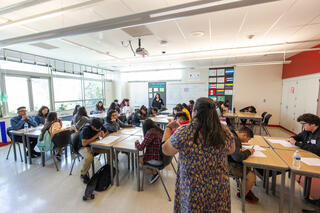

Teaching Resources
Teaching Resources
Explore our Acclaimed Learning Resources
Facing History’s dynamic collection of learning resources includes a wide range of flexible materials—from adaptable teaching strategies to topical lesson plans and practical toolkits to full curriculum units on topics like the Holocaust, Civil Rights, and media literacy. Our resources can transcend the classroom to spur learning at any age or interest level.
Learn more about how our materials, methods, and professional development help build classrooms full of teachers and students who can change the world.
How it Works
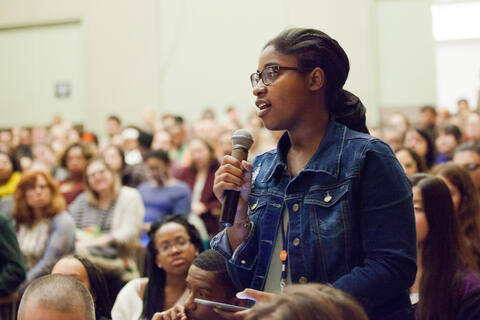
Attend an Event
Outstanding learning opportunities. Thought-provoking conversations. Inspiring stories from students and teachers. Join us for an upcoming event and experience the power of Facing History.
Donate now and together we'll build a better world
You might also be interested in…
6 New Books on Human Rights

Anti-Trans Legislation: How We Got Here and Why it Matters

#MeToo Past and Present: 3 New Books on Challenging Gender Violence
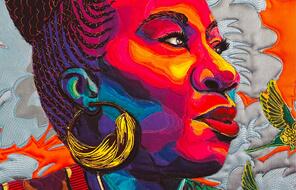
5 New YA Books on Women's History
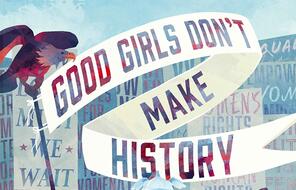
Why Genocide Recognition Matters
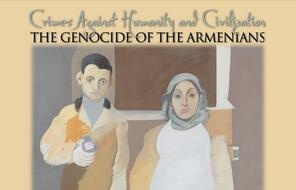
Today is the #WeNeedBlackTeachers Day of Action

Youth Activism and Grief on Earth Day

How to Build an Affirming Classroom in the Face of Anti-Trans Legislation

Remembering Rip Patton
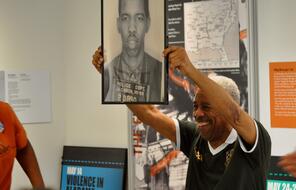
6 Resources for Teaching About 9/11

5 Timely Reads on Genocide

5 Tools for Teaching About Genocide
